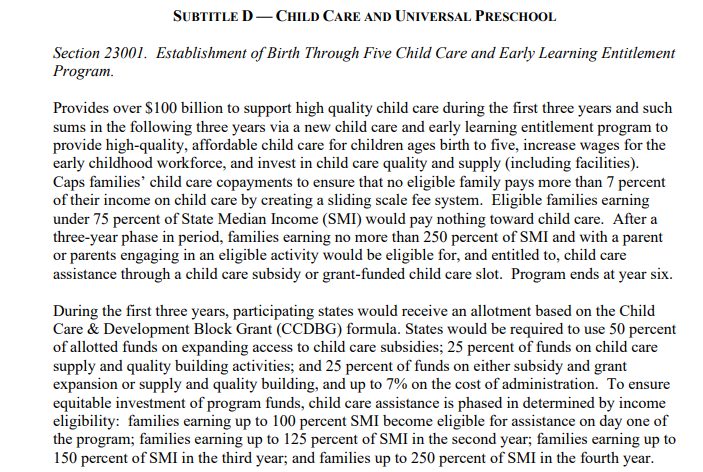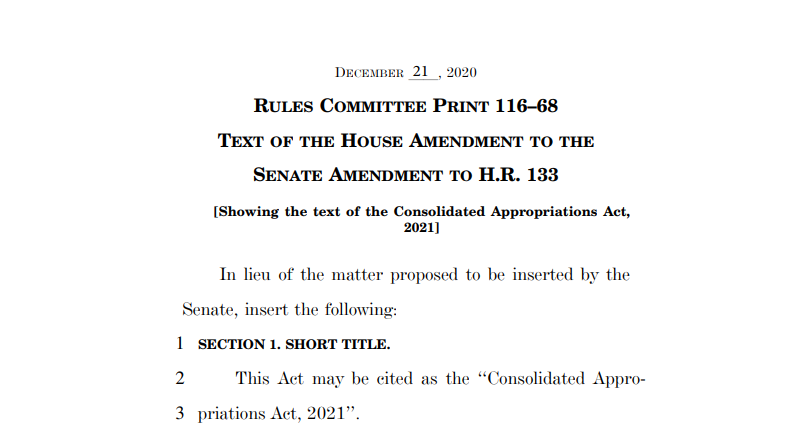Read What Is In The “Build Back Better Bill" for ECE/ChildCare/Young Children
The Build Back Better Bill and its potential impact on Early Childhood Education and Care along with children and families more generally has been in the news recently. But you may be wondering, what exactly is in the Bill? You can read the full bill ‘s text here
However, the bill is very long. So congress have created an official section by section summary of the bill which you can find at this link: Below, I have cut and past the parts of that summary most relevant to ECE. and young children in general.
“SUBTITLE D — CHILD CARE AND UNIVERSAL PRESCHOOL Section 23001. Establishment of Birth Through Five Child Care and Early Learning Entitlement Program. Provides over $100 billion to support high quality child care during the first three years and such sums in the following three years via a new child care and early learning entitlement program to provide high-quality, affordable child care for children ages birth to five, increase wages for the early childhood workforce, and invest in child care quality and supply (including facilities). Caps families’ child care copayments to ensure that no eligible family pays more than 7 percent of their income on child care by creating a sliding scale fee system. Eligible families earning under 75 percent of State Median Income (SMI) would pay nothing toward child care. After a three-year phase in period, families earning no more than 250 percent of SMI and with a parent or parents engaging in an eligible activity would be eligible for, and entitled to, child care assistance through a child care subsidy or grant-funded child care slot. Program ends at year six. During the first three years, participating states would receive an allotment based on the Child Care & Development Block Grant (CCDBG) formula. States would be required to use 50 percent of allotted funds on expanding access to child care subsidies; 25 percent of funds on child care supply and quality building activities; and 25 percent of funds on either subsidy and grant expansion or supply and quality building, and up to 7% on the cost of administration. To ensure equitable investment of program funds, child care assistance is phased in determined by income eligibility: families earning up to 100 percent SMI become eligible for assistance on day one of the program; families earning up to 125 percent of SMI in the second year; families earning up to 150 percent of SMI in the third year; and families up to 250 percent of SMI in the fourth year. Beginning in fiscal year 2025, the program provides such sums as may be necessary to carry out a child care entitlement program. Under the entitlement program, states would receive reimbursement from the federal government for the expenses needed to operate a child care entitlement program and would be required to serve all eligible children within the state who desire child care assistance. Creates a federal-state cost sharing structure, where the federal government covers 90 percent of the cost of direct child care services for children, and states would be required to cover 10 percent of expenses. Reimburses states at their Federal Medical Assistance Percentage (FMAP) rate for child care quality and supply activities and reimburses 50 percent of administrative expenses. States would be required to base child care payment rates on a statistically valid and reliable cost estimation model, and to ensure that payment rates cover the cost of high-quality child care and living wages for early childhood staff, as well as pay parity with similarly credentialed elementary school teachers. States would also be required to implement a tiered quality rating system and to support continuous quality improvement for child care providers within the state.
Provides funding for the HHS Secretary to expand Head Start and award Local Birth to Five Early Learning Grants to localities located in states that have made it apparent that they will not participate in the program. Eligible localities include a city, county, or other unit of general local government.
Section 23002. Universal Preschool. Provides over $18 billion during the first three years and such sums as may be necessary in the following three years for the HHS Secretary in collaboration with the ED Secretary, to carry out a universal, high-quality, free, inclusive, and mixed delivery preschool program. Eligible providers include licensed child care programs; Head Start grantees; LEAs; or a consortium of those entities. Requires states to develop and implement state preschool standards, and ensure all eligible providers meet such standards. Additionally, requires states to identify high-need communities within the state, and to roll out universal preschool programs in those communities first, before expanding throughout the rest of the state. For the first three years of the program, the federal share is equal to 100 percent of the state’s expenditures for preschool services, and no state match is required. In subsequent years, the federal/state share changes to 90/10, 75/25, and 60/40. Reserves $2,500,000,000 annually to improve compensation of Head Start staff. Program ends at year six. Provides funding for the HHS Secretary to expand Head Start and award universal preschool grants to localities located in states that have made it apparent that they will not participate in the program. Eligible localities include a Head Start agency, a local education agency (LEA), or a city, country, or other unit of general local government.
SUBTITLE E — CHILD NUTRITION AND RELATED PROGRAMS Section 24001. Expanding Community Eligibility. Invests in free school meals by allowing nearly 9 million more children to access meals through the Community Eligibility Provision (CEP). This section: (1) increases the CEP multiplier, which is used to determine the rate of federal reimbursement to schools, from 1.6 to 2.5; and (2) lowers the participation threshold for schools to elect CEP from 40 percent to 25 percent of identified students. Additionally, it allows for statewide election of CEP. These changes are in effect through FY26. Section 24003. Summer Electronic Benefit Transfer for Children Program. Invests in expanding the Summer Electronic Benefit Transfer (Summer EBT) program to provide nutrition benefits to eligible low-income children nationwide. The benefit provides $65/month for eligible children through FY2024.
Section 25002. Family Violence Prevention and Services Funding. Provides $30,000,000 for implementation of the grants for sexual assault survivors and for culturally specific services under the Family Violence Prevention and Services Act (FVPSA). Section 25003. Pregnancy Assistance Fund. Provides $75,000,000 for competitive grants to support health care and community support services for pregnant women, parenting women, and young families. Section 25004. Funding for the Aging Services Network and Infrastructure.
Section 30801. Investments to Strengthen CHIP. This section makes comprehensive improvements to the Children’s Health Insurance Program (CHIP) for low-income children. It authorizes permanent funding for CHIP. It provides permanent funding for several programs related to CHIP, including the pediatric quality measures program and the child enrollment contingency fund to provide states with additional funding in the event its CHIP allotment is insufficient. It also closes a longstanding loophole and ensures that all CHIP programs are able to receive low-cost prescription drugs. Finally, this section provides states with the option to increase CHIP income eligibility levels above the existing statutory ceiling..”





